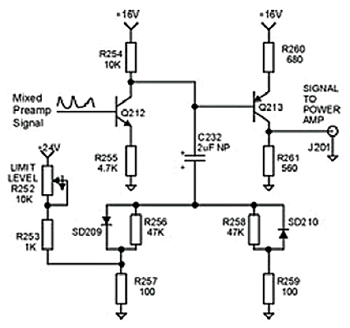 Last month I mentioned my fondness for the Thomas Vox line of solid state amps, and touched on some of the things they contained which were really ahead of their time. This month I’d like to look at the adjustable limiter they placed ahead of their power amps – in this case, the Beatle model 1143•6.
Last month I mentioned my fondness for the Thomas Vox line of solid state amps, and touched on some of the things they contained which were really ahead of their time. This month I’d like to look at the adjustable limiter they placed ahead of their power amps – in this case, the Beatle model 1143•6. The three Beatle preamp channels are mixed into a single output for the power amp. Transistor Q212 takes that combined signal, amplifies it and sends it on to PNP transistor Q213 where it’s amplified again and sent to the power amp. Between Q212 and Q213 is the adjustable limiter. Capacitor C232 shunts the signal to a pair of diodes, SD209 and SD210. These are paralleled by 47K resistors and have 100-ohm resistors in series with them to ground.
If you ignore the Limit Level pot and R253 leading to SD209 for a moment, this network looks like a standard effects-type clipping setup with two back-to-back diodes. It’s fancied up a bit with the parallel and series resistors, but it’s a diodes-to-ground clipper, like you would find in an old MXR Distortion Plus. This has a clipping threshold equal to the diode thresholds, which are fixed as part of the physics of the silicon at about 0.5 to 0.6V.
R252 and R253 are what change that. Compared to the 100-ohm R257, the 10K pot and 1K resistor are so large that they have no effect on the signal current coming out of SD209. That’s all handled by R257, but they are connected to +24V and pass DC current through R257 and this raises the cathode of SD209 above ground. Now instead of SD209 turning on when the signal level hits 0.5V, it turns on at 0.5V plus whatever voltage is across the 100-ohm. That works out to an extra 0.25V, or an extra 50% or so. That’s a lot when you’re talking about diode voltages.
The 47K resistors distribute that extra voltage so that half of it is applied to C232, rebalancing the clipping so that both SD209 and SD210 clip at half of the extra voltage. This is important for the limiter so the power amp gets equal signal limiting on both sides. In addition, the 100-ohm resistors soften the clipping of both SD209 and SD210, which helps make the sound smoother.
So why am I going on about a circuit which last appeared in a production amp over 30 years ago?
Well, if you happen to have a solid state amp you might be interested in making it sound smoother when it runs into overload. This circuit is simple enough for the apprentice circuit hacker to build into his amp. I’ve added this to several solid state amps and it’s a nice touch. It’s definitely a better sound when pushed to overload than amps without it. Think of it as an overdrive softener for your solid state amp.
Then again, those of you who build your own effects will be interested in a distortion where you can adjust the hardness of the clipping (as opposed to only how hard you drive the clipper) via a control adjustment. I have modified the circuit of an old MXR Distortion Plus with this adjustable clipper, and it adds a new dimension of colors to the spectrum available from the box.
From what I’ve read, the AC30 designer, Dick Denney, consulted with Thomas Organ for JMI after Thomas abandoned the British tube designs. I can’t verify it, but I suspect that Denney was involved in this limiter. He was faced with a bad situation that he could not control; Thomas Organ could produce solid state amps if they wanted. Given that, the Vox name was on the amps, and I think that Denney was making the best of the situation – and he did it well enough to provide some inspiration for us, from a distance of three decades.
R.G. Keen
Cheif Engineer
Visual Sound
www.visualsound.net













![Rig Rundown: Russian Circles’ Mike Sullivan [2025]](https://www.premierguitar.com/media-library/youtube.jpg?id=62303631&width=1245&height=700&quality=70&coordinates=0%2C0%2C0%2C0)





